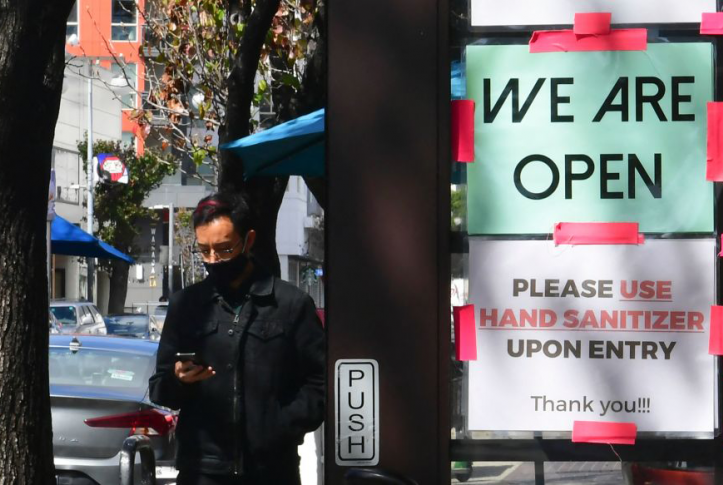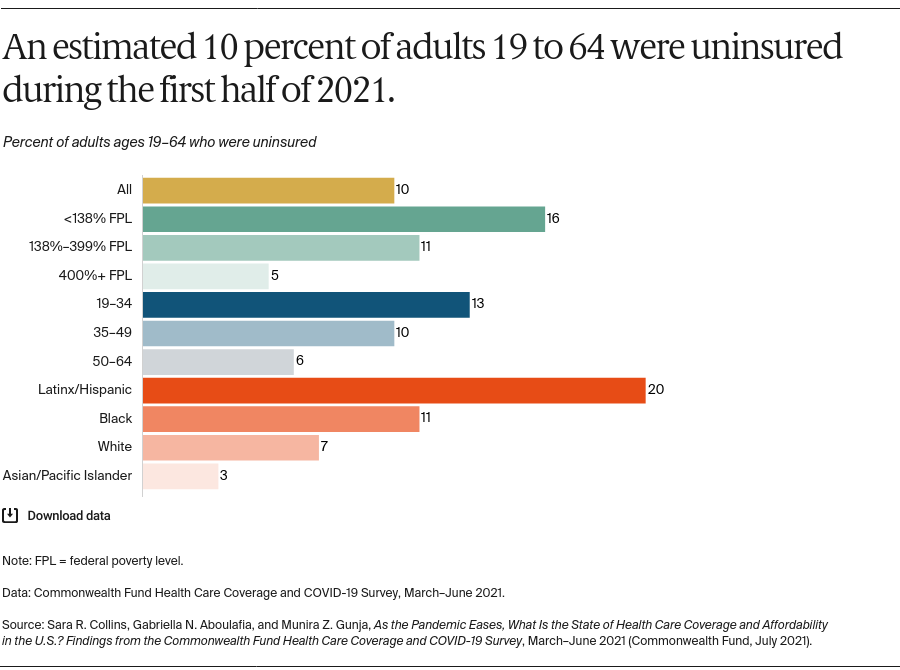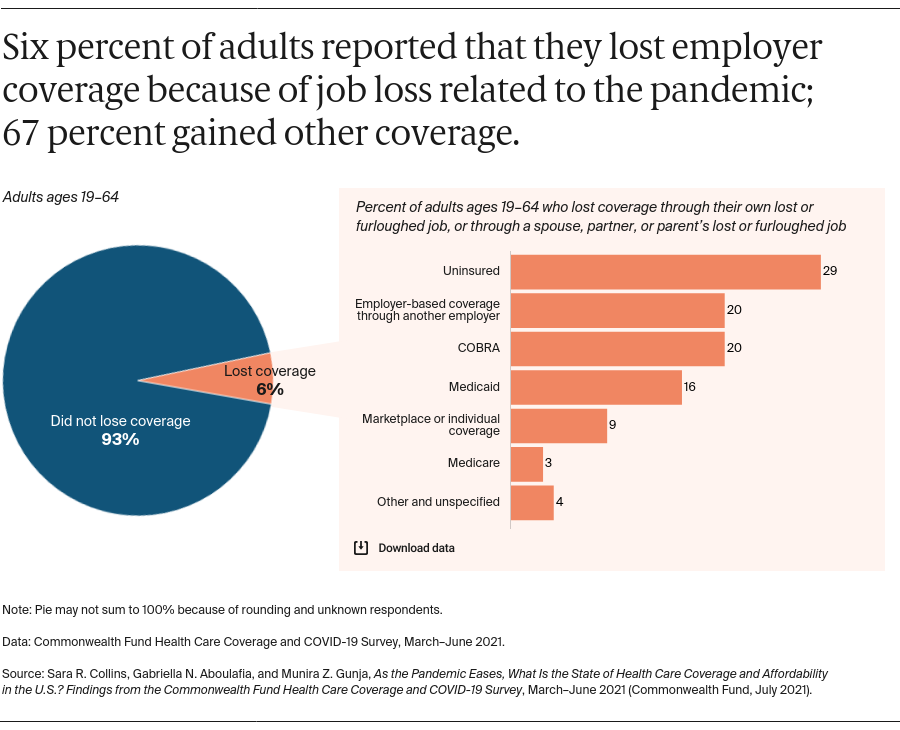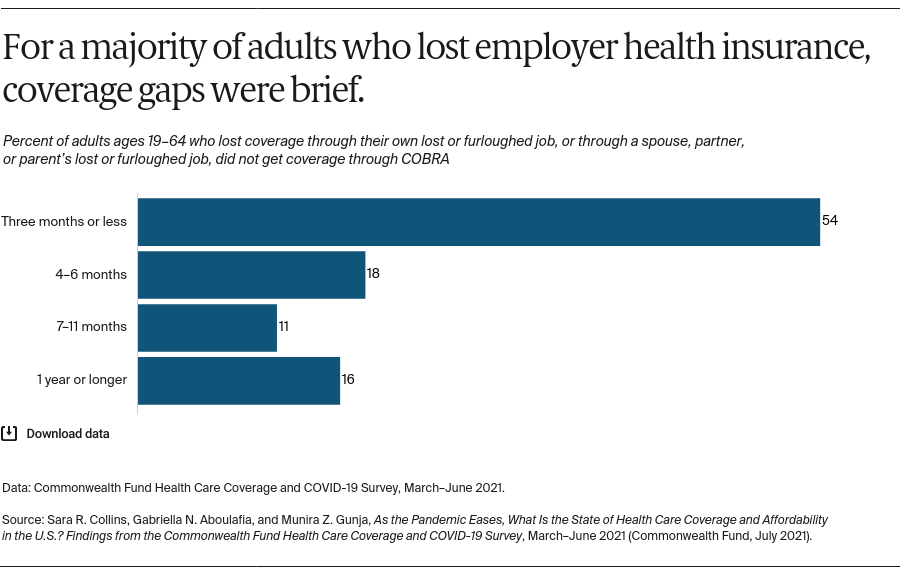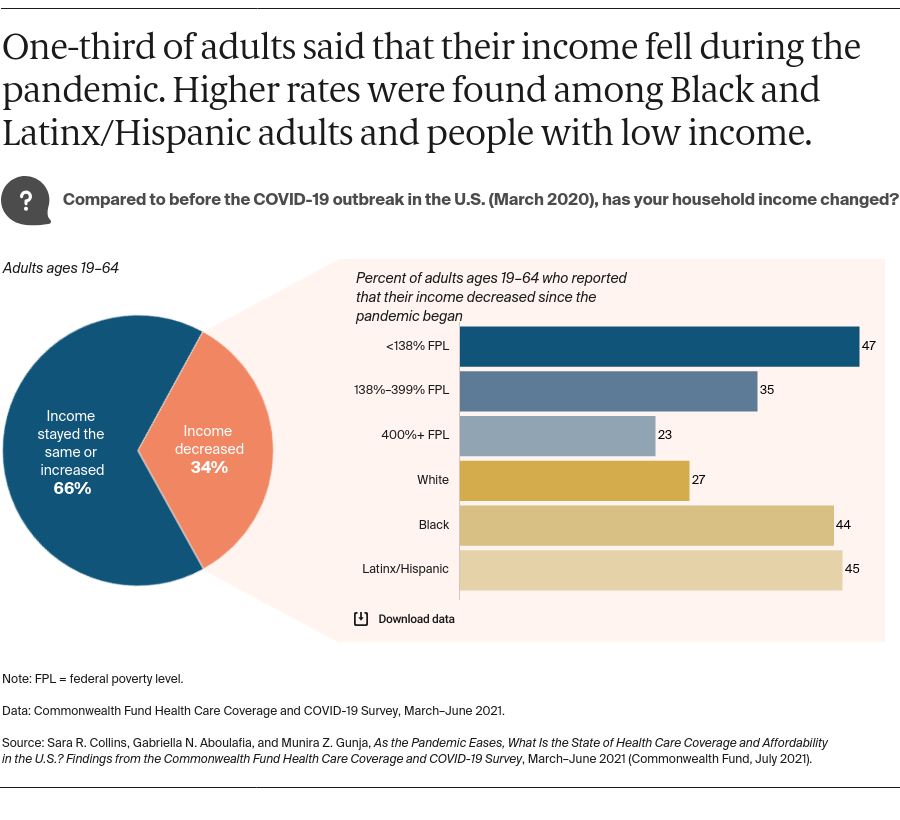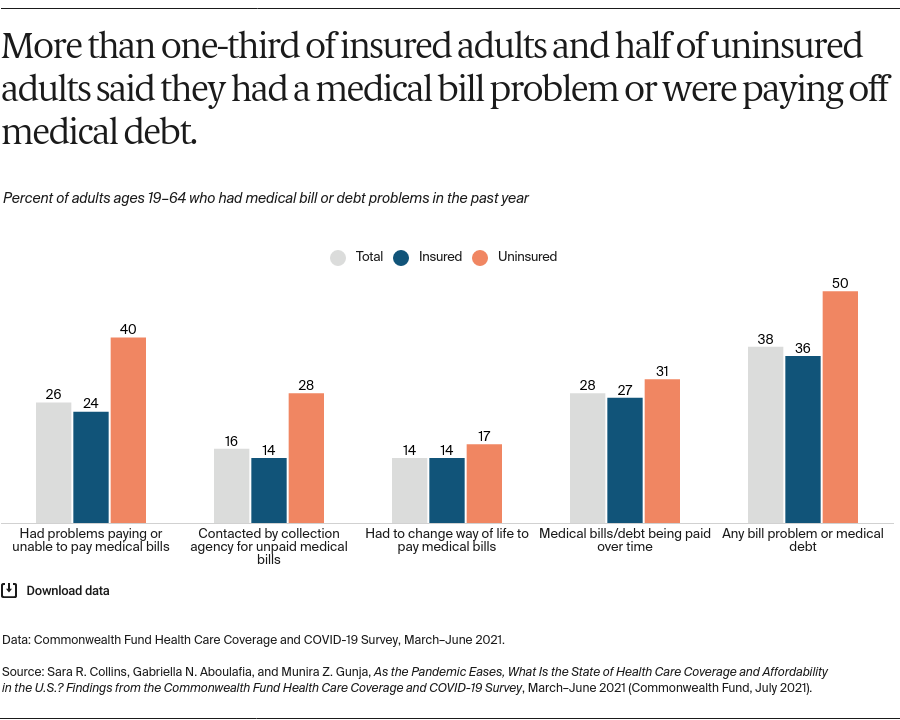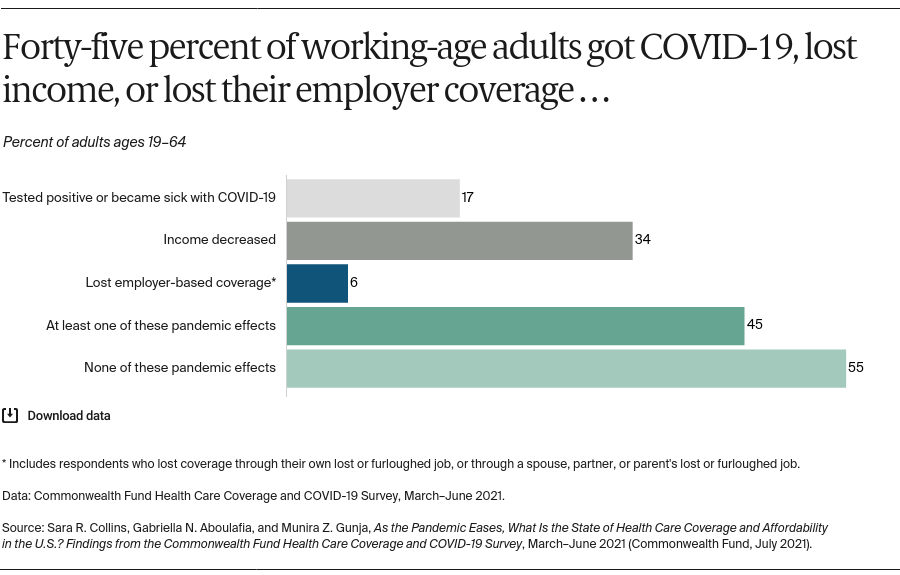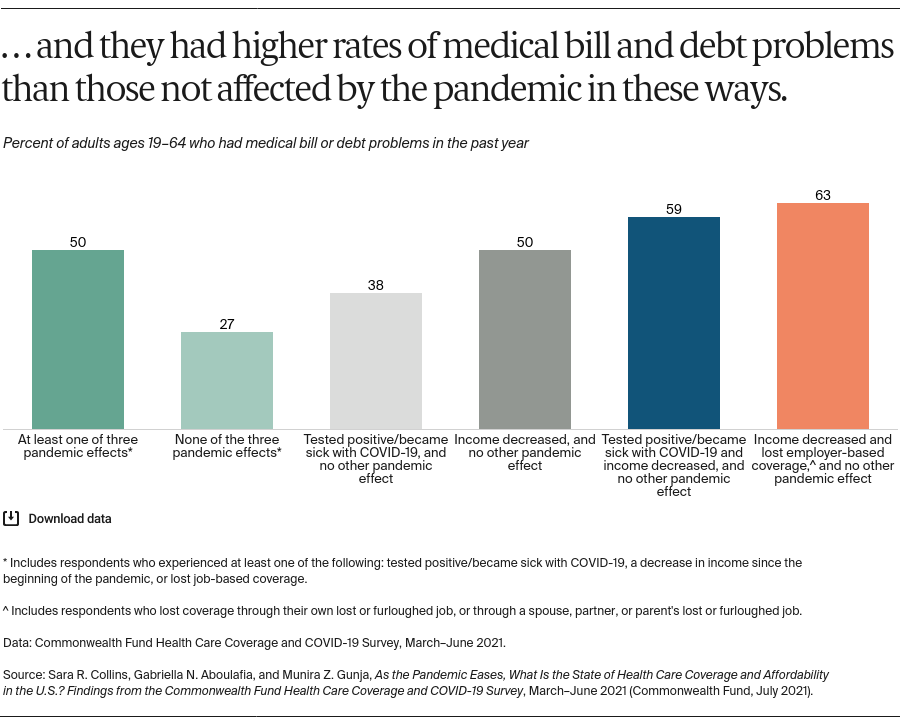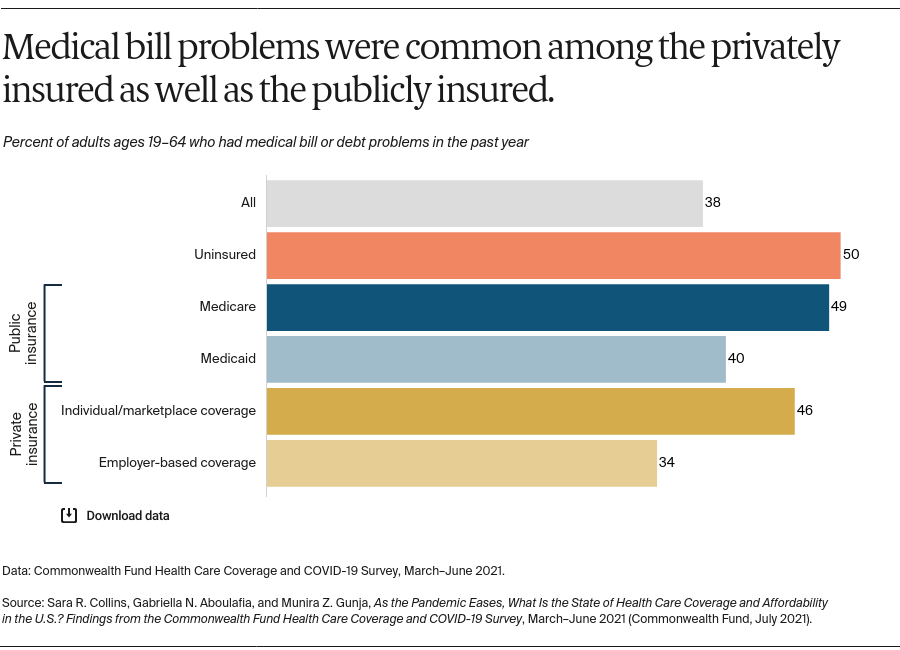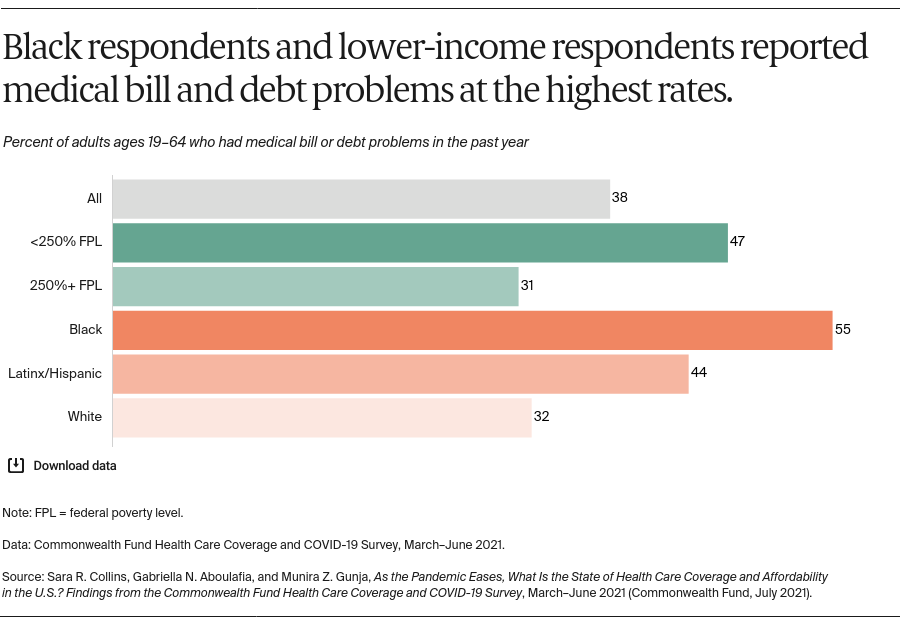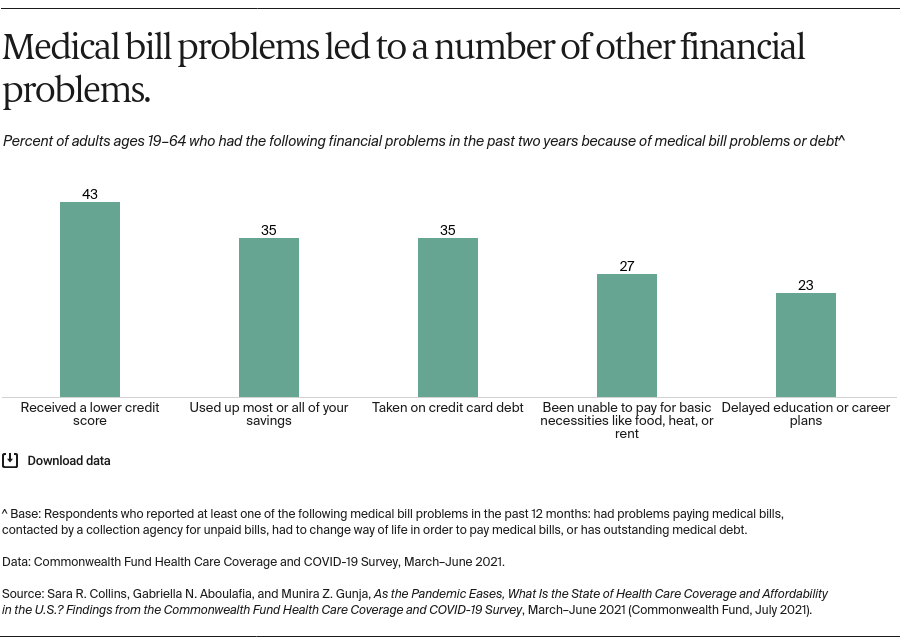1. The Commonwealth Fund Health Care Coverage and COVID-19 Survey has a maximum margin of sampling error of +/– 1.8 percentage points at the 95 percent confidence interval. As estimates get further from 50 percent in either direction, the margin of sampling error decreases. This is why the estimated uninsured rate has a smaller margin of sampling error.
2. National Center for Health Statistics and U.S. Census Bureau, “Health Insurance Coverage: Household Pulse Survey,” last reviewed June 30, 2021.
3. Sarah Sugar et al., Medicaid Churning and Continuity of Care: Evidence and Policy Considerations Before and After the COVID-19 Pandemic (Assistant Secretary for Planning and Evaluation, Office of Health Policy, Apr. 2021); and Sara Rosenbaum, Morgan Handley, and Rebecca Morris, Winding Down Continuous Enrollment for Medicaid Beneficiaries When the Public Health Emergency Ends (Commonwealth Fund, Jan. 2021).
4. Sugar et al., Medicaid Churning, 2021.
5. Madeline O’Brien and Sabrina Corlette, “State Action Related to COVID-19 Relief: Expanding Access to Affordable Coverage Options,” Commonwealth Fund, last updated June 28, 2021.
6. Centers for Medicare and Medicaid Services, “2021 Marketplace Special Enrollment Period Report,” fact sheet, July 14, 2021; Centers for Medicare and Medicaid Services, “Effectuated Enrollment: Early 2021 Snapshot and Full Year 2020 Average,” June 5, 2021; Andrew Sprung, “Obamacare Mid-Year Enrollment Is Likely Up 19% over Past Peak,” XPOSTFACTOID (blog), June 10, 2021; and Charles Gaba, “Breaking: CMS Announces Over 1.24 Million Have Enrolled Via HC.Gov SEP So Far; #GetCovered Thru 8/15,” ACASignups.net (blog), June 14, 2021.
7. Centers for Medicare and Medicaid Services, December 2020 and January 2021 Medicaid and CHIP Enrollment Trends Snapshot (CMS, June 2021).
8. Sara R. Collins et al., An Early Look at the Potential Implications of the COVID-19 Pandemic for Health Insurance Coverage — Commonwealth Fund Health Care Poll: COVID-19, May–June 2020 (Commonwealth Fund, June 2020); Paul Fronstin and Stephen A. Woodbury, How Many Americans Have Lost Jobs with Employer Health Coverage During the Pandemic? (Commonwealth Fund, Oct. 2020); Paul Fronstin and Stephen A. Woodbury, “Update: How Many Americans Have Lost Jobs with Employer Health Coverage During the Pandemic?,” To the Point (blog), Commonwealth Fund, Jan. 11, 2021; and Jessica Banthin et al., Changes in Health Insurance Coverage Due to the COVID-19 Recession: Preliminary Estimates Using Microsimulation (Urban Institute, July 2020).
9. Fronstin and Woodbury, How Many Americans?, 2020.
10. Sara R. Collins, Munira Z. Gunja, and Gabriella N. Aboulafia, U.S. Health Insurance Coverage in 2020: A Looming Crisis in Affordability — Findings from the Commonwealth Fund Biennial Health Insurance Survey, 2020 (Commonwealth Fund, Aug. 2020).
11. Collins et al., U.S. Health Insurance Coverage, 2020; and Sara R. Collins, Herman K. Bhupal, and Michelle M. Doty, Health Insurance Coverage Eight Years After the ACA: Fewer Uninsured Americans and Shorter Coverage Gaps, But More Underinsured (Commonwealth Fund, Feb. 2019).
12. Sophie Beutel, Munira Z. Gunja, and Sara R. Collins, How Much Financial Protection Do Marketplace Plans Provide in States Not Expanding Medicaid? (Commonwealth Fund, June 2016).
13. Collins et al., U.S. Health Insurance Coverage, 2020; Sara R. Collins, David C. Radley, and Jesse C. Baumgartner, State Trends in Employer Premiums and Deductibles, 2010–2019 (Commonwealth Fund, Nov. 2020); and Sherry A. Glied and Benjamin Zhu, Catastrophic Out-of-Pocket Health Care Costs: A Problem Mainly for Middle-Income Americans with Employer Coverage (Commonwealth Fund, Apr. 2020).
14. Jack Hoadley and Kevin Lucia, “Putting Surprise Billing Protections into Practice: Biden Administration Releases First Set of Regulations,” To the Point (blog), Commonwealth Fund, July 14, 2021.
15. The White House, “Fact Sheet: The American Families Plan,” Apr. 28, 2021; and Jessica Banthin et al., What if the American Rescue Plan’s Enhanced Marketplace Subsidies Were Made Permanent? Estimates for 2022 (Urban Institute, Apr. 2021).
16. D. Keith Branham, Christie Peters, and Benjamin D. Sommers, Estimates of Uninsured Adults Newly Eligible for Medicaid If Remaining Non-Expansion States Expand (Assistant Secretary for Planning and Evaluation, Office of Health Policy, May 2021); Sherry A. Glied and Richard G. Frank, “Extend Marketplace Coverage to Insure More People in States That Have Not Expanded Medicaid,” To the Point (blog), Commonwealth Fund, June 10, 2021; John Holahan et al., Filling the Gap in States That Have Not Expanded Medicaid Eligibility (Commonwealth Fund, June 2021); Sara Rosenbaum, Morgan Handley, and Rebecca Morris, “How the Experience of Insuring Legal Immigrants Can Offer Insights into Insuring Eligible Residents in Medicaid Nonexpansion States,” To the Point (blog), Commonwealth Fund, June 3, 2021; and Sara Rosenbaum, “Confronting the Consequences of National Federation of Independent Business v Sebelius to Insure the Poor,” Milbank Quarterly Opinion, Apr. 13, 2021.
17. Sugar et al., Medicaid Churning, 2021.
18. Linda J. Blumberg, John Holahan, and Jason Levitis, How Auto-Enrollment Can Achieve Near-Universal Coverage: Policy and Implementation Issues (Commonwealth Fund, June 2021).
19. Improving Health Insurance Affordability Act of 2021, S. 499, 117th Cong. (2021); and Linda J. Blumberg et al., From Incremental to Comprehensive Health Insurance Reform: How Various Reform Options Compare on Coverage and Costs (Urban Institute, Oct. 2019).
20. Timothy S. Jost, “Eliminating the Family Glitch,” To the Point (blog), Commonwealth Fund, May 18, 2021; and Matthew Buettgens and Jessica Banthin, Changing the “Family Glitch” Would Make Health Coverage More Affordable for Many Families (Urban Institute, May 2021).
21. Karen Pollitz and Daniel McDermott, Claims Denials and Appeals in ACA Marketplace Plans (Henry J. Kaiser Family Foundation, Jan. 2021).
22. Linda J. Blumberg et al., Comparing Health Insurance Reform Options: From “Building on the ACA” to Single Payer (Commonwealth Fund, Oct. 2019); John Holahan, Michael Simpson, and Linda J. Blumberg, What Are the Effects of Alternative Public Option Proposals (Urban Institute, Mar. 2021); and Sherry A. Glied and Jeanne M. Lambrew, “How Democratic Candidates for the Presidency in 2020 Could Choose Among Public Health Insurance Plans,” Health Affairs 37, no. 12 (Dec. 2018): 2084–91.
23. Commonwealth Fund Health Care Coverage and COVID-19 Survey, March–June 2021.
24. SSRS, “SSRS Opinion Panel,” n.d.
25. NCHS and Census, “Household Pulse Survey,” 2021.
26. U.S. Census Bureau, “Source of the Data and Accuracy of the Estimates for the Household Pulse Survey – Phase 3.1,” n.d.
27. Robin A. Cohen et al., Health Insurance Coverage: Early Release of Estimates from the National Health Interview Survey, Jan-June 2020 (National Center for Health Statistics, Feb. 2021).
28. National Center for Health Statistics, “About the National Health Interview Survey,” last reviewed Sept. 16, 2020.
29. Collins et al., U.S. Health Insurance Coverage, 2020.
30. Michael Karpman, Stephen Zuckerman, and Graeme Peterson, Adults in Families Losing Jobs During the Pandemic Also Lost Employer-Sponsored Health Insurance (Urban Institute, July 2020).
31. Urban Institute, “Health Reform Monitoring Survey: HRMS Frequently Asked Questions,” n.d.
32. Katherine Keisler-Starkey and Lisa N. Bunch, Health Insurance Coverage in the United States: 2019 (U.S. Census Bureau, Sept. 2020).
33. U.S. Census Bureau, “CPS Methodology,” n.d.
